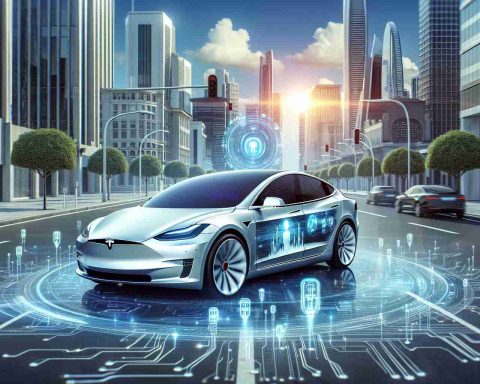The UK Moves Towards a Greener Future
Recent insights reveal that the UK is on course to achieve its ambitious electric vehicle (EV) sales target for 2024, despite some automakers expressing concerns about the feasibility of these goals. The government’s zero-emission vehicle (ZEV) rule accounts for both fully electric cars and lower-emission hybrid vehicles.
Data from the Energy and Climate Intelligence Unit (ECIU) indicates that fully electric vehicles are expected to constitute over 19% of the market this year, while hybrids are projected to make up around 3%. On average, industry compliance with the ZEV mandate is projected to reach the target of 22% per manufacturer, with expectations of rising percentages in the coming years—28% by 2025, and a robust 80% by 2030.
Colin Walker, from the ECIU, highlighted the positive impact of the mandate, noting that it is effectively reducing costs while boosting sales of cleaner vehicles. Some automakers, however, are lagging, with leaders like BMW, Mercedes, and Hyundai already exceeding their targets.
With penalties in place for any manufacturer exceeding pollution limits, the Society of Motor Manufacturers and Traders (SMMT) stressed the need for more flexibility in meeting these demanding goals. SMMT CEO Mike Hawes emphasized that while registrations are increasing, manufacturers are facing significant pressure to adapt quickly, necessitating a regulatory framework that fosters growth and competition in the EV market.
UK Electric Vehicle Market: Trends, Innovations, and Challenges Ahead
The electric vehicle (EV) landscape in the UK is undergoing significant transformations as the nation rightfully shifts toward a greener future. With ambitious targets set for 2024, the implications of the zero-emission vehicle (ZEV) rule are becoming more evident. Here’s an in-depth look at emerging trends, innovations, market analysis, and the challenges that lie ahead for the EV sector.
Key Trends in the EV Market
1. Rising Market Share of EVs: According to the Energy and Climate Intelligence Unit (ECIU), over 19% of the UK car market is expected to consist of fully electric vehicles in 2023. This trend highlights increasing consumer acceptance and awareness regarding the benefits of EVs.
2. Increased Compliance and Future Projections: Manufacturers are projected to comply with the ZEV mandate at a rate of approximately 22% this year, with forecasts suggesting that this will rise to 28% by 2025 and soar to 80% by 2030. This push for compliance reflects the urgency among automakers to align with government policies.
3. Enhanced Availability of Charging Infrastructure: The scale-up of EVs is accompanied by a corresponding increase in charging infrastructure. Cities across the UK are investing heavily in public charging stations, making it more convenient for consumers to adopt electric models.
Innovations Driving the EV Sector
– Battery Technology Advancements: Continual improvements in battery technology, including increases in energy density and reductions in charging time, are expected to enhance the attractiveness of EVs. Companies are investing in solid-state batteries, which promise higher efficiency and safety.
– Integration with Smart Technologies: The integration of AI and smart grid technologies in electric vehicles is enhancing user experience through features like optimized route planning and real-time charging station availability.
Pros and Cons of the Transition to EVs
Pros:
– Environmental Benefits: Reduced carbon emissions contribute to a healthier planet.
– Cost Savings: Lower operating costs over time compared to internal combustion engines.
– Government Incentives: Various subsidies and incentives facilitate the purchase of electric vehicles.
Cons:
– Initial Purchase Price: Despite falling prices, EVs generally still come with a higher initial cost than traditional vehicles.
– Range Anxiety: The limited range of some electric vehicles compared to traditional cars can be a concern for consumers.
– Battery Disposal and Sustainability: The environmental impact of battery production and disposal remains a contentious issue.
Market Insights and Future Predictions
The UK’s shift towards electric mobility is not just about compliance; it represents a fundamental change in consumer behavior and industry priorities. Analysts predict that by 2030, the UK could be one of the leading markets for electric vehicles in Europe. Factors influencing this trajectory include:
– Regulatory Support: Continuing government regulations aimed at reducing emissions are critical for maintaining momentum.
– Consumer Demand: Increased public awareness about sustainability is driving demand for EVs more than ever before.
Challenges Facing Automakers
While leading manufacturers like BMW, Mercedes, and Hyundai have begun to exceed their targets, other firms are struggling to keep pace. The Society of Motor Manufacturers and Traders (SMMT) calls for more flexibility in the regulatory framework, as manufacturers adjust to an evolving marketplace filled with technological advancements and competition.
Conclusion
As the UK approaches its ambitious electric vehicle sales targets for 2024, staying informed about market dynamics, regulatory changes, and consumer preferences is vital. The emphasis on sustainability presents an opportunity for innovation while also posing significant challenges for manufacturers. Stakeholders in the automotive industry must collaboratively navigate this landscape to fully realize the potential of electric vehicles in creating a greener future.
For further information on the latest developments in the EV market, visit the UK Government.








